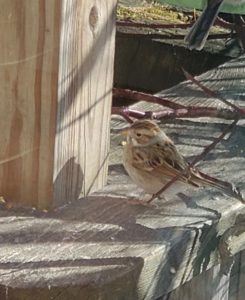With the recent cold weather its hard to remember that we are now 2/3rd’s of the way through the worst of winter. This time of year, with cold and viruses trying to drain the life from us, we need something we need something to lift our spirits. For many of us, even in the dead of winter, nature provides that. Even if we are just looking out the window from the warmth of our homes.
If you have planted native trees, shrubs, and wildflowers, your property is an oasis for nature. Native plants fully interact with  the animals which live around here, including the birds which either stay or visit for the winter. At the nature center, we are continually planting to bring the birds to us, and it works. Although we have a wonderful and diverse nature preserve, often the best place to see birds is right around the nature center building itself. Of course, hanging bird feeders and offering a variety of desirable food doesn’t hurt in that regard.
the animals which live around here, including the birds which either stay or visit for the winter. At the nature center, we are continually planting to bring the birds to us, and it works. Although we have a wonderful and diverse nature preserve, often the best place to see birds is right around the nature center building itself. Of course, hanging bird feeders and offering a variety of desirable food doesn’t hurt in that regard.
 the animals which live around here, including the birds which either stay or visit for the winter. At the nature center, we are continually planting to bring the birds to us, and it works. Although we have a wonderful and diverse nature preserve, often the best place to see birds is right around the nature center building itself. Of course, hanging bird feeders and offering a variety of desirable food doesn’t hurt in that regard.
the animals which live around here, including the birds which either stay or visit for the winter. At the nature center, we are continually planting to bring the birds to us, and it works. Although we have a wonderful and diverse nature preserve, often the best place to see birds is right around the nature center building itself. Of course, hanging bird feeders and offering a variety of desirable food doesn’t hurt in that regard.In our best bird feeding area, birds are sheltered by ninebark, American highbush cranberry, and red cedars, with serviceberry and chokeberry mixed in. They are located near the feeders, and also provide wild fruit for birds, at least for a while. Their cover provides a place for small songbirds to shelter if a Cooper’s hawk comes around looking for a meal.
This time of year, the birds visiting the feeders are a bit different than are here during the summer. Some, like the hardy chickadees, cardinals, house finches and house sparrows spend their whole lives right in the neighborhood and their faithful persistence provides a baseline for activity around the building. This year a couple of adult red-winged blackbirds, found by the hundreds in the nearby marsh in the summer, have elected to stay around to mingle with the more typical year-round species. There are others who summer in the far north and visit here for the winter, as though Woodland Dunes is their Florida vacation spot. Juncos, which are actually a species of sparrow, come down beginning in late September and remain until April or May. One of the last species to come to us each winter is the American tree sparrow, which nests in the very far north and journeys here in October and November- we always know that winter is seriously upon us when they show up. They are tiny but incredibly hardy, feeding on the ground on even the coldest of days, scratching seed from the snow in the midst of fierce winds. I don’t know how a small bird weighing just a few grams can stay warm under such conditions, but they do. Come April they will grow restless, and suddenly depart when warm south winds aid in their spring migration.
Occasionally other birds show up. This year a clay-colored sparrow, a drab, small species normally found in Mexico in winter, has decided to linger, and visits the feeders each day for the last several weeks. It is not a colorful or charismatic bird by any means- rather it is a bird which is easily overlooked. Just the fact that it has decided to stay is special for our staff- we work hard to provide birds with the things they need to survive, and it’s being here reaffirms that. It certainly makes a quick look at the bird feeders all the more interesting.
Feeding wild birds is a way to keep tabs on and connect with nature even when it is too harsh to make outside activity enjoyable. Bird feeding is also a big business- people spend $4 billion on bird food each year. In return birds give us enjoyment, clean up waste, pollinate plants, plant seeds, and a variety of other real benefits. It is no surprise that tens of millions of people attract wild birds to their yards. In the face of Covid and everything else, we need birds more than ever. This is especially true during the coldest, and least friendly, time of year.
photo- clay-colored sparrow at Woodland Dunes by Kennedy Zittel
